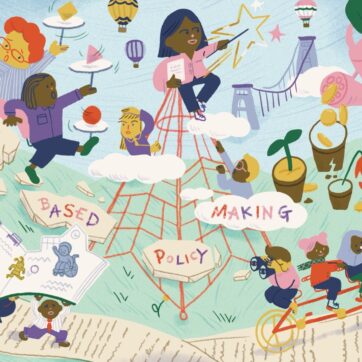If we don’t give Arts & Humanities researchers the tools to write successful policy-oriented research funding bids, they will only write bad ones. If they only write bad ones, reviewers won’t be exposed to what a high-quality bid looks like and won’t be able to provide constructive criticism. With no tools and no criticism, Arts & Humanities researchers won’t be able to develop the necessary skills and will stick to writing high-quality research-focused funding bids. If senior researchers only write research-focused bids, junior researchers won’t have any models or examples to learn from. Without any discipline-wide experience, Arts & Humanities researchers won’t acquire the tools needed to write successful policy-oriented research funding bids. Now start from the top.
This is the chicken and egg situation many A&H researchers are faced with when at the start of their policy engagement journey, and one of the many barriers preventing A&H research and knowledge to inform decision-making. While we acknowledge that there isn’t one secret magic formula for writing policy impact into bids, we want to at least try and crack open the egg with some insight that other A&H researchers might be able to use for their next funding bid.
Pathway to Impact
Those of us who have been around the block at least once will remember that UKRI Research Councils used to have a section in all of their funding applications called “Pathway to Impact” – a neatly distinct section where applicants could explain how they were planning on achieving policy impact. This was scrapped a few years back, leaving many researchers stumped: if there is not Pathway section, where am I supposed to talk about impact? The answer is both reassuring and daunting: anywhere and everywhere. Indeed, reviewers now expect your pathway to impact to be seamlessly woven into the entirety of the bid. This brings us our first red flag: if you’re only talking about policy stakeholders in one paragraph, thrown in at the end of your dissemination plan alongside your proposed monograph, that sends the signal you’ve not actually given much thought about impact at all.
If this was your last research funding application, don’t worry, fixing this is not as complicated as it seems.
Research Questions
Let’s start with the one element you can’t write a bid without: research questions. There is a widespread assumption in the academic community that to be successful in a funding bid one must have a fully formed, unchangeable set of research questions, , and that indeed any uncertainty or vagueness around the research question is a sure-fire signal of failure. But there’s a difference between your research questions being vague and being a work in progress.
Many researchers, including A&H researchers, see engagement with stakeholders as an ‘add on’ at the end of a research project, but the number one most effective thing you can do in policy engagement actually happens at the start of a project: co-designing your research questions with a policy partner. Sure, you might have a good idea of the project and key questions you’re interested in, but if your goal is to influence policy in any way, nothing is going to be more valuable than sitting down with the policymaker you are trying to influence, and talking through what their policy questions are, and what the barriers are to achieving your impact goal. Then you’re no longer creating knowledge for their consumption (something they might or might not be interested in), but you are co-creating knowledge with them, knowledge that directly answers their questions and is by its own nature usable, accessible and relevant.
Going back to the original point, you don’t need to have your research questions set in stone before you start, as long as you are clear in your application on how you will achieve that, and build in enough time and resources at the start to do so.
Theory of Change
Say your policy partners have agreed to sit down with you and shape those research questions at the start of the project – how do you actually keep working with them and ensure they stay engaged? This is where a Theory of Change (ToC) comes in handy. While we no longer have a Pathway to Impact section, a ToC is easiest and most practical way of ‘visualising’ your Pathway. There are many versions of the ToC model out there, as there are many valid alternatives (see benefit maps or logic models), but they all boil down to the same principles: plan, measure and evaluate.
Think of your ToC as your action plan: how are you going to approach your stakeholders, how you will work with them, what they’ll do different as a result, and how this helps you achieve your final goal. You research project might actually be one of the many steps of a larger ToC!
Then break it down to practical steps: could you have an Advisory Board for your project? Give private briefings as soon as you have early findings? Run workshops to co-create recommendations before they’re made public? Here, there is no one size fits all, but think creatively about ways to ensure you are co-creating knowledge with your policy partners and about whether the activities and engagements you are putting into your plan are the right types of thing to do with the users of your research. Also, a nice Gantt chart never hurt anyone.
Letters of Support
Now it’s time to capture it all. When it comes to external engagement in general, but specifically policy engagement, the most convincing element of a funding application is actually not in the application itself – it’s the Letters of Support. Rest assured that reviewers do read them, and are actually quite critical of their quality, so make sure that you use them to their maximum potential.
While it’s tempting to use a ready-made letter for all your partners, that’s easy to spot and makes your application look sloppy. Instead, you can use a template but make sure you customize the bulk of the text to reflect your partner’s involvement. For example, make sure you leave space for them to articulate what they will get from the project, include a detailed breakdown of their involvement (better yet if you can put a figure against any in-kind contributions!), and most importantly build in the time and resources for evaluation, so that your partners commit to being involved all the way through to that point in the project. With your Theory of Change in mind, think through how you want to capture the impact of your work – is it through a pre-post questionnaire, is it through a qualitative feedback interview? Regardless, make sure your partners are aware of the expectation, and that they sign it off in the Letter of Support.
So here it is – not a magic formula, but a few ideas to get you started on your next research funding bid. If you need further support, make sure you reach out to the Impact team at your institution who will be able to provide guidance. And if you have any other tips to add to our list, get in touch to share them with the UPEN Subcommittee on Arts & Humanities.
Do you have an example case study where arts & humanities research influenced policy? Get in touch with Arlene Holmes Henderson at arlene.v.holmes-henderson@durham.ac.uk.


